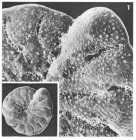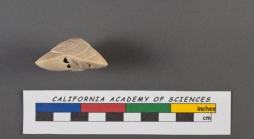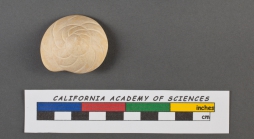Foraminifera name details
Trochulina d'Orbigny in Ehrenberg, 1839
416110 (urn:lsid:marinespecies.org:taxname:416110)
unaccepted (Nomen nudum see Hansen & Revets (1992))
Genus
Rotalia (Trochuline) turbo d'Orbigny, 1826 accepted as Rotalia turbo d'Orbigny in Deshayes, 1832 accepted as Trochulina turbo (d'Orbigny in Deshayes, 1832) accepted as Discorbina turbo (d'Orbigny in Deshayes, 1832) (type by subsequent designation)
Rotalia (Trochuline) d'Orbigny, 1826 · unaccepted (name not available. ICZN Art. 11...)
name not available. ICZN Art. 11 (b)(i): 11 (g): vernacular
- Species Trochulina lenticularis Hewaidy & Al-Hitmi, 1994 †
- Species Trochulina complanata (d'Orbigny, 1850) † accepted as Discorbis complanata (d'Orbigny, 1850) †
- Species Trochulina dimidiata (Jones & Parker, 1862) accepted as Lamellodiscorbis dimidiatus (Jones & Parker, 1862) (In opinion of Hansen & Revets (1992))
- Species Trochulina dimidiatus (Jones & Parker, 1862) accepted as Trochulina dimidiata (Jones & Parker, 1862) accepted as Lamellodiscorbis dimidiatus (Jones & Parker, 1862) (Genus is feminine)
- Species Trochulina ferussaci (d'Orbigny, 1850) † accepted as Asterigerina ferussaci d'Orbigny, 1850 †
- Species Trochulina mira (Cushman, 1922) accepted as Rotorbis auberii (d'Orbigny, 1839)
- Species Trochulina rosea (d'Orbigny in Guérin-Méneville, 1832) accepted as Rotorbinella rosea (d'Orbigny in Guérin-Méneville, 1832) (Redescription of the genus Rotorbinella, Revets (2001))
- Species Trochulina turbo (d'Orbigny in Deshayes, 1832) accepted as Discorbina turbo (d'Orbigny in Deshayes, 1832) (unaccepted > superseded combination, Type species of Discorbina)
marine, brackish, fresh, terrestrial
Ehrenberg, C.G. (1839). Über die Bildung der Kreidefelsen und des Kreidemergels durch unsichtbare Organismen. <em>Abhandlungen der Königlichen Akademie der Wissenschaften zu Berlin, Physikalische Klasse.</em> 1838: 59-147, pls. 1-4., available online at https://www.biodiversitylibrary.org/page/29017435
page(s): Chart opp. p. 120 [details]
page(s): Chart opp. p. 120 [details]
Taxonomy Hansen and Revets (1992): The nomenclatorial history of this species is very confused.
D’Orbigny failed to give either a...
D’Orbigny failed to give either a...
Taxonomy Hansen and Revets (1992): The nomenclatorial history of this species is very confused.
D’Orbigny failed to give either a description or a drawing, effectively
demoting the species to a nom. nud. The species name turbo became
available for the first time by the publication of Carpenter, Parker and
Jones (1862), in which a description of the species is given by Parker and
Jones (p. 204), but without an illustration. Thus, Parker and Jones are
deemed to have instated the species turbo, their description constituting an
indication (ICZN art. 12, paragraph b). The fact that the subgeneric name
‘Trochuline’ was given in French by d’Orbigny makes it an unavailable
name. Ehrenberg (1839) used the name Trochulina in a list, but without
description, author or illustration, rendering it once again a nom. nud.
Trochulina first became available in the work of Basset (1885), since the
assignation of a valid species name to a new genus-group name constitutes
an indication.
Unknown source:
Trochulina was considered to be a junior homonym of a coral genus by the same name but Levy et al (1980, 1986) showed that there was no valid attribution of a coral to this name and thus d'Orbigny's foraminiferal genus is retained and is a senior synonym of Discorbina Parker & Jones, 1862 which has the same type species. [details]
D’Orbigny failed to give either a description or a drawing, effectively
demoting the species to a nom. nud. The species name turbo became
available for the first time by the publication of Carpenter, Parker and
Jones (1862), in which a description of the species is given by Parker and
Jones (p. 204), but without an illustration. Thus, Parker and Jones are
deemed to have instated the species turbo, their description constituting an
indication (ICZN art. 12, paragraph b). The fact that the subgeneric name
‘Trochuline’ was given in French by d’Orbigny makes it an unavailable
name. Ehrenberg (1839) used the name Trochulina in a list, but without
description, author or illustration, rendering it once again a nom. nud.
Trochulina first became available in the work of Basset (1885), since the
assignation of a valid species name to a new genus-group name constitutes
an indication.
Unknown source:
Trochulina was considered to be a junior homonym of a coral genus by the same name but Levy et al (1980, 1986) showed that there was no valid attribution of a coral to this name and thus d'Orbigny's foraminiferal genus is retained and is a senior synonym of Discorbina Parker & Jones, 1862 which has the same type species. [details]
Hayward, B.W.; Le Coze, F.; Vachard, D.; Gross, O. (2021). World Foraminifera Database. Trochulina d'Orbigny in Ehrenberg, 1839. Accessed at: http://www.marinespecies.org/foraminifera/aphia.php?p=taxdetails&id=416110 on 2024-04-25
Date
action
by
2009-09-23 14:01:30Z
created
db_admin
original description
Ehrenberg, C.G. (1839). Über die Bildung der Kreidefelsen und des Kreidemergels durch unsichtbare Organismen. <em>Abhandlungen der Königlichen Akademie der Wissenschaften zu Berlin, Physikalische Klasse.</em> 1838: 59-147, pls. 1-4., available online at https://www.biodiversitylibrary.org/page/29017435
page(s): Chart opp. p. 120 [details]
additional source Loeblich, A. R.; Tappan, H. (1987). Foraminiferal Genera and their Classification. Van Nostrand Reinhold Company, New York. 970pp., available online at https://books.google.pt/books?id=n_BqCQAAQBAJ [details] Available for editors [request]
[request]
source of synonymy Hansen, H. J.; Revets, S. (1992). A revision and reclassification of the Discorbidae, Rosalinidae, and Rotaliidae. <em>The Journal of Foraminiferal Research.</em> 22(2): 166-180., available online at https://doi.org/10.2113/gsjfr.22.2.166
page(s): p. 167 [details] Available for editors [request]
[request]
page(s): Chart opp. p. 120 [details]
additional source Loeblich, A. R.; Tappan, H. (1987). Foraminiferal Genera and their Classification. Van Nostrand Reinhold Company, New York. 970pp., available online at https://books.google.pt/books?id=n_BqCQAAQBAJ [details] Available for editors
source of synonymy Hansen, H. J.; Revets, S. (1992). A revision and reclassification of the Discorbidae, Rosalinidae, and Rotaliidae. <em>The Journal of Foraminiferal Research.</em> 22(2): 166-180., available online at https://doi.org/10.2113/gsjfr.22.2.166
page(s): p. 167 [details] Available for editors
 Present
Present  Inaccurate
Inaccurate  Introduced: alien
Introduced: alien  Containing type locality
Containing type locality
From editor or global species database
Diagnosis Test trochospiral, biconvex to planoconvex, chambers slightly inflated, sutures moderately oblique on the spiral side, curved and radial on the umbilical side, foliar extension at the umbilical margin of the chamber, umbilicus filled with one to three large granules or plugs that may fuse with the folium, periphery angular, interior with paries proximus as an arched plate that attaches to the chamber floor and extends both forward and backward to produce a foliar chamberlet at the umbilical margin, dividing the septal foramen into one part that communicates with the main chamber cavity and a second part that opens into the foliar chamberlet; primary aperture interiomarginal, extending from the umbilicus to the peripheral carina, secondary aperture on the umbilical side near the base of the folium, allowing the foliar chamberlet to communicate with the exterior, in species that do not have a completely isolated foliar chamberlet, the secondary aperture may also communicate with the adjacent chamber in front of the paries proximus. M. Eocene to Holocene; cosmopolitan. (Loeblich & Tappan, 1987, Foraminiferal Genera and Their Classification) [details]Taxonomy Hansen and Revets (1992): The nomenclatorial history of this species is very confused.
D’Orbigny failed to give either a description or a drawing, effectively
demoting the species to a nom. nud. The species name turbo became
available for the first time by the publication of Carpenter, Parker and
Jones (1862), in which a description of the species is given by Parker and
Jones (p. 204), but without an illustration. Thus, Parker and Jones are
deemed to have instated the species turbo, their description constituting an
indication (ICZN art. 12, paragraph b). The fact that the subgeneric name
‘Trochuline’ was given in French by d’Orbigny makes it an unavailable
name. Ehrenberg (1839) used the name Trochulina in a list, but without
description, author or illustration, rendering it once again a nom. nud.
Trochulina first became available in the work of Basset (1885), since the
assignation of a valid species name to a new genus-group name constitutes
an indication.
Unknown source:
Trochulina was considered to be a junior homonym of a coral genus by the same name but Levy et al (1980, 1986) showed that there was no valid attribution of a coral to this name and thus d'Orbigny's foraminiferal genus is retained and is a senior synonym of Discorbina Parker & Jones, 1862 which has the same type species. [details]





